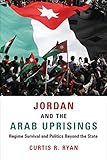Jordan and the Arab Uprisings : Regime Survival and Politics Beyond the State / Curtis R. Ryan.
Material type: TextSeries: Columbia Studies in Middle East PoliticsPublisher: New York, NY : Columbia University Press, [2018]Copyright date: ©2018Description: 1 online resourceContent type:
TextSeries: Columbia Studies in Middle East PoliticsPublisher: New York, NY : Columbia University Press, [2018]Copyright date: ©2018Description: 1 online resourceContent type: - 9780231186261
- 9780231546560
- online - DeGruyter
- Issued also in print.
| Item type | Current library | Call number | URL | Status | Notes | Barcode | |
|---|---|---|---|---|---|---|---|
 eBook
eBook
|
Biblioteca "Angelicum" Pont. Univ. S.Tommaso d'Aquino Nuvola online | online - DeGruyter (Browse shelf(Opens below)) | Online access | Not for loan (Accesso limitato) | Accesso per gli utenti autorizzati / Access for authorized users | (dgr)9780231546560 |
Browsing Biblioteca "Angelicum" Pont. Univ. S.Tommaso d'Aquino shelves, Shelving location: Nuvola online Close shelf browser (Hides shelf browser)

|

|

|

|

|

|

|
||
| online - DeGruyter Ulysses by Numbers / | online - DeGruyter The Tale of Cho Ung : A Classic of Vengeance, Loyalty, and Romance. | online - DeGruyter Dickinson's Nerves, Frost's Woods : Poetry in the Shadow of the Past / | online - DeGruyter Jordan and the Arab Uprisings : Regime Survival and Politics Beyond the State / | online - DeGruyter Media U : How the Need to Win Audiences Has Shaped Higher Education / | online - DeGruyter Worlds of Journalism : Journalistic Cultures Around the Globe / | online - DeGruyter How Did Lubitsch Do It? / |
Frontmatter -- Contents -- Preface and Acknowledgments -- List of Abbreviations -- I. Continuity and Change Amid the Arab Uprisings -- II. The Arab Spring Protests in Jordan -- III. Political Parties and the "Traditional" Opposition -- IV. The Hirak and Changes in Political Activism -- V. Identity Politics, Real and Imagined -- VI. Struggles Over Elections and Electoral Systems -- VII. Rebooting Reform -- VIII. War, Refugees, and Regional Insecurity -- IX. Jordanian Politics Beyond the Arab Uprisings -- Notes -- Bibliography -- Index
restricted access online access with authorization star
http://purl.org/coar/access_right/c_16ec
In 2011, as the Arab uprisings spread across the Middle East, Jordan remained more stable than any of its neighbors. Despite strife at its borders and an influx of refugees connected to the Syrian civil war and the rise of ISIS, as well as its own version of the Arab Spring with protests and popular mobilization demanding change, Jordan managed to avoid political upheaval. How did the regime survive in the face of the pressures unleashed by the Arab uprisings? What does its resilience tell us about the prospects for reform or revolutionary change?In Jordan and the Arab Uprisings, Curtis R. Ryan explains how Jordan weathered the turmoil of the Arab Spring. Crossing divides between state and society, government and opposition, Ryan analyzes key features of Jordanian politics, including Islamist and leftist opposition parties, youth movements, and other forms of activism, as well as struggles over elections, reform, and identity. He details regime survival strategies, laying out how the monarchy has held out the possibility of reform while also seeking to coopt and contain its opponents. Ryan demonstrates how domestic politics were affected by both regional unrest and international support for the regime, and how regime survival and security concerns trumped hopes for greater change. While the Arab Spring may be over, Ryan shows that political activism in Jordan is not, and that struggles for reform and change will continue. Drawing on extensive fieldwork and interviews with a vast range of people, from grassroots activists to King Abdullah II, Jordan and the Arab Uprisings is a definitive analysis of Jordanian politics before, during, and beyond the Arab uprisings.
Issued also in print.
Mode of access: Internet via World Wide Web.
In English.
Description based on online resource; title from PDF title page (publisher's Web site, viewed 29. Mrz 2022)


